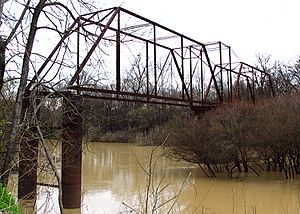Sunflower River facts for kids
The Sunflower River is an important waterway in Mississippi, USA. It is also known as the Big Sunflower River. This river is one of the main streams that flow into the Yazoo River. The Yazoo River then joins the mighty Mississippi River.
The Sunflower River is long, stretching about 100 miles (160 kilometers). It starts in De Soto County, close to the border with Tennessee. From there, it flows south until it reaches the Yazoo River. Barges can travel on about 50 miles (80 kilometers) of the river, making it useful for moving goods.
The United States Army Corps of Engineers helps keep a special channel open for boats. This channel is about 30 miles (48 kilometers) long and was built in 1976. It is used by both large barges and smaller pleasure boats.
Contents
River Features and Flow
The Sunflower River has a few other names, like Hushpuckaman Creek. Other smaller rivers and streams also feed into it. These include the Hushpuckena River, the Quiver River, and Bogue Phalia. All these waters flow through the rich, fertile soil of the Yazoo Delta.
Near the town of Sunflower, Mississippi, the river's flow is quite strong. About 1,099 cubic feet (31 cubic meters) of water pass by every second. That's like filling a small swimming pool in just a few seconds!
Water Quality and Appearance
The Sunflower River often carries a lot of mud, just like the Yazoo River. This mud comes from rain washing soil into the bayous and small streams that feed the river.
When the Sunflower River meets the Yazoo River, you can often see a clear "Clear-Mud Line." This line shows that the Big Sunflower River is usually muddier than the Yazoo River where they join.
History and Culture Along the River
Long ago, Native American people lived along the Sunflower River. Early explorers found many large earth mounds built by these ancient cultures. These mounds were created by groups who lived there before the Choctaw and Chickasaw peoples.
A famous researcher named Clarence Bloomfield Moore studied some of these earthworks. He found important sites near Holly Bluff, not far from Lake George.
Today, the city of Clarksdale, which is the main town in Coahoma County, hosts a special event. Every year, the Sunflower River Blues & Gospel Festival is held there, celebrating music and culture.
Wildlife and Protected Areas
Most of the land along the Sunflower River is used for farming. For a long time, cotton was the main crop grown here. These are often large, industrial farms.
However, some important natural areas have been set aside to protect wildlife. These are called national wildlife refuges. There are three of them along the river:
- The Holt Collier National Wildlife Refuge
- The Dahomey National Wildlife Refuge
- The Panther Swamp National Wildlife Refuge
The U.S. Fish and Wildlife Service manages all these refuges. They help protect the forests and the animals that live there.


